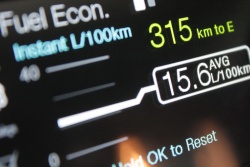 Photo by Chris Chase. Click image to enlarge |
|
Related links
Manufacturer’s web site |
By Jil McIntosh
Gas is definitely in the news these days as its price climbs to record levels. It’s always on the minds of the reviewers at Autos.ca – we may not pay for our test cars, but we do pay for the fuel we use – and so, whenever possible, we include information on the fuel consumption we experience.
That can lead to all sorts of emails and reader comments, asking why our mileage is often considerably worse (or, far less frequently, much better) than the official published fuel figures for the vehicle. There are several factors contributing to that, but one major reason is a simple one: we’re human.
Contrary to what you might expect, fuel consumption isn’t gauged on a test track. In fact, the car isn’t really driven at all during the test. It’s all performed in a laboratory, which eliminates variables, and is done by the automakers in procedures that are standardized to government specifications. The results are handed over to Natural Resources Canada, which compiles each year’s fuel figures into its ecoENERGY consumption ratings for the public’s use.
The automaker starts with a vehicle that has about 6,000 kilometres on it for “run-in” and tests it on a dynamometer. A two-cycle test is used – a more realistic five-cycle test, already adopted by the U.S. government, is under consideration in Canada – that simulates city and highway driving. For the city portion, the test represents a 12-kilometre stop-and-go trip, with an average speed of 32 km/h and a top speed of 91 km/h. The 23-minute test includes 18 stops, including four minutes of test time spent idling to represent waiting at traffic lights.
The test is done with a cold engine similar to one that’s been sitting overnight in the summer. The first eight minutes of the test are then repeated with a hot engine start, similar to a vehicle that has been driven, stopped for a short time, and then started up again. The highway trip starts with a hot engine and runs for 31 minutes, covering a simulated 16 kilometres at an average speed of 77 km/h and a top speed of 97 km/h. The speed varies to simulate different highway and rural roads. The test staff doesn’t measure the amount of fuel gone from the tank, but analyzes the exhaust, calculating the fuel consumption from the emissions generated.
Transport Canada occasionally audits the results. Vehicles selected for audit testing include those with advanced technologies that are new or recent to the Canadian market, high-production volume models popular with buyers, and models that haven’t been tested in quite a while. Also subject to audit are those where the automaker reports higher or lower fuel consumption data than expected, or models with previous discrepancies between the reported figures and independent audit test ratings. In this case, the government buys vehicles from dealerships through a bidding process and puts 3,500 km on the odometer using a specific route, specific speeds and a single driver. The fuel is drained and replaced with a standardized test fuel. The vehicle is tested on a dynamometer, where its emissions are analyzed and compared with the figures submitted by the car company.











